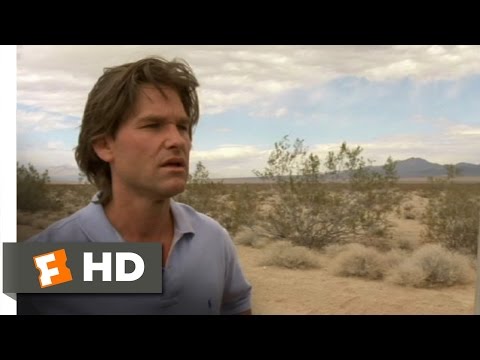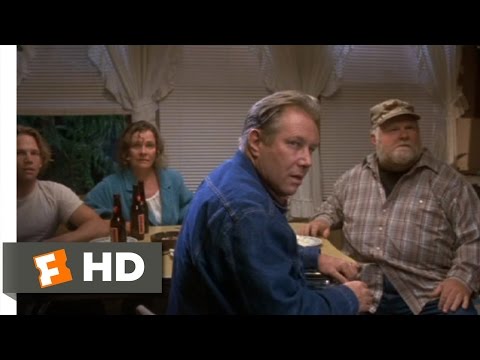Jonathan Mostow’s “Breakdown” (1997) stars Kurt Russell and Kathleen Quinlan as Jeff and Amy Taylor, a Massachusetts couple on a road trip and moving to San Diego.
The opening credits set the tone properly, as composer Basil Poledouris’ percussive score, perfectly matched by the lines of a road map, taking us into dry, unforgiving desert vistas and barren roads. The first scene shows Amy, while Jeff takes his eyes off the road for just a second and nearly hits a truck.
The tension begins at a gas station and never ceases for the remainder of the film.

A tense, seemingly random encounter with Earl (M.C. Gainey), a truck driver at a gas station, is the first thing to go wrong for the Taylors. Then the Taylors’ Grand Jeep Cherokee has a breakdown on the side of the road, leading them to putting faith in a total stranger named “Red” (J.T. Walsh) and trusting that everything will turn out fine, as it usually does for this couple.
The Taylors are driving a nice, expensive vehicle but aren’t familiar with cars and are used to comfort. They’re about to have the worst 24 hours of their lives.
Echoes of “Duel” (1971), “The Vanishing” (1988), “The Hitcher” (1986) and, much later, “Joy Ride” (2001) and “Red Lights”(2004) come to mind. Mostow, who authored the story and co-wrote the screenplay with Sam Montgomery, threw out any line or moment that could have come across as padded or unnecessary.
There’s simply no filler here, as every scene has a purpose.
The seemingly needless, tossed off detail of a $90,000.00 jackpot on the side of a donut wrapper becomes a key plot thread in the second act. Mostow is telling us to watch closely and embrace the desperate, wide-eyed perspective of Russell’s character.
RELATED: Why Original ‘Cat People’ Trumps ’80s Remake
Russell is an ideal Everyman. He has kind eyes that convey vulnerability, but he’s tough enough to be believable when Jeff finds the will to fight back. Like the comparably lean and exhilarating “The Fugitive” (1993), it never leaves the perspective of its tortured protagonist, and, for a brief spell, we question Jeff the same way we’re initially not 100 percent sure about Dr. Richard Kimball.
Here, Jeff doesn’t have the equivalent of a Lt. Sam Gerard to promise that justice will eventually prevail. Jeff is on his own. The bank scene is an exercise in Hitchcockian visual paranoia: note the camera angles that seem to be judging Jeff.
A very long time passes before our hero gets the upper hand and, even then, never has much of an advantage. Jeff is up against the most loathsome villains since the crew that shot up Officer Alex J. Murphy in “RoboCop” (1987).
A disturbing touch that stands out – once Jeff enters the villain’s lair, such as it is, it’s not out of “The Texas Chainsaw Massacre” (1974) or resembling a war room or the den of a serial killer. Nope, its plain, ordinary and homey.
The “bad guys” of “Breakdown” are especially unsettling because they’re recognizable, out in the open and carefree about what they do.

Walsh, the late, magnificent character actor, is terrifying, cold, imposing and mysterious as Red; in other words, the perfect villain. Because Walsh isn’t playing the talking killer, we lean in every time he utters a word.
Watch him closely during the third act scenes set in a barn – even without dialog, Walsh is conveying so much. Walsh died at the age of 54 in 1998. “Breakdown” was one of his last great performances. As actors go, he was one of our best. Also noteworthy is Gainey, perfectly scary and every bit as essential to pulling us in as Walsh.
“Breakdown” was one of the best films produced by Martha and Dino DeLaurentis during this period. The last name tends to bring up memories of big budget flops/cult classics like “King Kong” (1976), “Flash Gordon” (1980) and “Dune” (1984). However, this was a good era for them, as other worthy works included “Army of Darkness” and “Dragon: The Bruce Lee Story” (both 1993).
“Breakdown” opened early in the summer of 1997, and emerged a sleeper hit with legs that stuck around via great word of mouth.
FAST FACT: “Breakdown” earned a solid $50 million at the US box office in 1997. That year’s biggest hit? “Men in Black” with $250 million.
The film was acclaimed in ’97 but feels today like a tight-as-a-drum masterpiece. Nevertheless, I’ve only watched it a few times, as it has always succeeded in putting me in a total state of anxiety.
Here’s a crazy thing to admit: whenever I watch this, it has to be from start to finish, as I can’t bear to leave it at the midpoint and not see Jeff’s journey through to the end, both because of how good the film is and because I don’t want to abandon Russell.
Mostow’s film creates a feeling of dread that is almost unbearable and unrelenting. Aside from the antiquated cell phone and use of a phone book, nothing here feels dated.
An early scene where Jeff goers to Belle’s Diner and can’t find his wife concludes with a crane shot that indicates the total isolation Jeff is feeling. Everything the 1994 American remake of “The Vanishing” did wrong, “Breakdown” does right.
Mostow’s film has editing, sound design, cinematography and pacing that are as superb as the performances.
Here is a terrific collection of character actors, all ideally and wisely assigned: Rex Linn as the trying-to-be-helpful Sheriff and Jack McGee as the nice-until-pushed diner owner are especially vivid.
RELATED: Kurt Russell Rocks Red Suit in ‘Christmas Chronicles’
The first act set-up grabs us because nothing feels inevitable – we know the villain is Walsh’s Red and we’ve seen him drive away with Jeff’s wife but…did Jeff somehow get the wrong guy?
Unlike in “The Vanishing,” the villain isn’t established right away, and we’re stuck with Russell’s sympathetic but kind of annoying protagonist – we’re getting to know him in the midst of a crisis and can’t always trust his choices or the mild arrogance in which he presents himself to the locals.
We’re initially unsure if Amy’s disappearance is a big conspiracy (as we, like Jeff, begin to distrust all the good ole’ boy figures in the plot) or if a crime has only been committed by just a couple of characters. For a film with familiar plot elements (the “Duel” comparison is especially deserving), the audience won’t get ahead of the story any more than Russell’s Jeff will outthink his opponents.
As blood thirsty and crowd pleasing as the final moment is, the film, earns it. There’s a final detail that bugs me about the last scene: is it really over for the antagonist and will the cops believe his side of the story?
After all, considering where Mostow concludes the narrative, doesn’t the evidence in view present more questions than answers? It seems “Breakdown,’ even once it ends, never loosens its agonizing hold on us.
The post “Breakdown’ – A Surprise Sleeper in ’97, a Masterpiece Today appeared first on Hollywood in Toto.
from Movies – Hollywood in Toto https://ift.tt/3gaicRO

No comments:
Post a Comment